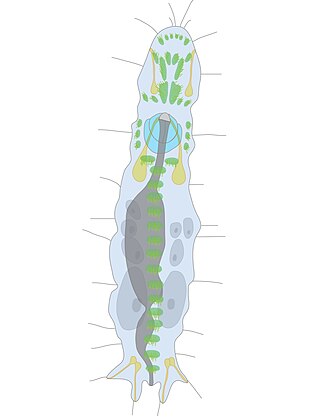
Haplodrili, or Archiannelida, is an order of primitive polychaete worms. Zoologist Ray Lankester gave it the name haplodrili, while zoologist Berthold Hatschek later named it Archiannelida. Once considered to be a class under Annelida, and even a separate phylum, Haplodrili is now widely accepted to be an order under Polychaeta. Species in this order are known for completely lacking external segments.

Eunicida is an order of polychaete worms.
The Onuphidae are a family of polychaete worms.

Diurodrilus is a genus of tiny marine animals that has traditionally been assigned to the annelid worms, although this affinity is not certain. With a maximum length of 0.45 mm, it has an unusual morphology with many traits not found in other annelids, including a ventral creeping foot. Analyses of DNA have both refuted and supported placement within the annelids, with the unusual morphology perhaps due to evolutionary progenesis, in which organisms develop sexual maturity while retaining the larval traits of their ancestors.

Eulalia viridis is a species of bright-green polychaete worm in the family Phyllodocidae. It can range from 5 to 15 cm in length and is usually found in shallow north Atlantic water under rocks or in mussel beds.

The Euphrosinidae are a family of polychaete worms. The name is from Greek Euphrosyne, meaning merriment; she was one of the three Graces.

Scalibregma inflatum, also known as T headed worm, is a burrowing marine polychaete. It is a cosmopolitan species that can be found from the Arctic to Antarctica, although most probably several species are confounded.

Phyllodoce lineata is a species of polychaete worm in the family Phyllodocidae. It is native to the northeastern Atlantic Ocean and the Mediterranean Sea where it occurs in the intertidal and shallow sub-tidal zones on soft sediment.
Eunoe alvinella is a scale worm described from a specimen collected at a depth of 2725 m on the East Pacific Rise.
Eunoe bathydomus is a scale worm known from the north Atlantic Ocean at depths of 2000–3500 m.
Eunoe serrata is a scale worm described from the South Atlantic Ocean off the coast of Brazil at depths down to about 200m.
Admetella hastigerens is a scale worm known from the east Pacific Ocean at depths of about 1000–1200m.
Bathyadmetella is a genus of marine annelids in the family Polynoidae. The only species in the genus, Bathyadmetella commando, is known from a single specimen collected at 1646m in the north-west Pacific Ocean.
Austropolaria is a genus of marine annelids in the family Polynoidae. The genus includes a single species, Austropolaria magnicirrata, which is known only from the Amundsen Sea in the Southern Ocean, at depths of 1000 to 1500m.
Bathyeliasona kirkegaardi is a deep-sea scale worm which is only known to occur in the Pacific Ocean, where it is recorded from a depth range of about 5,500–8,000 m.
Vampiropolynoe is a genus of marine polychaete worms belonging to the family Polynoidae, the scaleworms. Vampiropolynoe contains a single species, Vampiropolynoe embleyi which is known from hydrothermal vents in the South Pacific Ocean at a depth of about 1500 m.
Verrucapelma is a genus of marine annelids in the family Polynoidae. Verrucapelma contains three species which are known from shallow water down to a depth of about 90 m. All three species occur in the Indo-Pacific region, in the Coral Sea, northern Australia and the Indonesian archipelago.
Verrucapelma nigricans is a scale worm known from the South China Sea from intertidal habitats.
Verrucapelma nigricans is a scale worm known from the South China Sea from intertidal habitats.
Verrucapelma retusa is a scale worm known from northern Australia, the Timor Sea and the Coral Sea from shallow water to depths of about 20 m.






